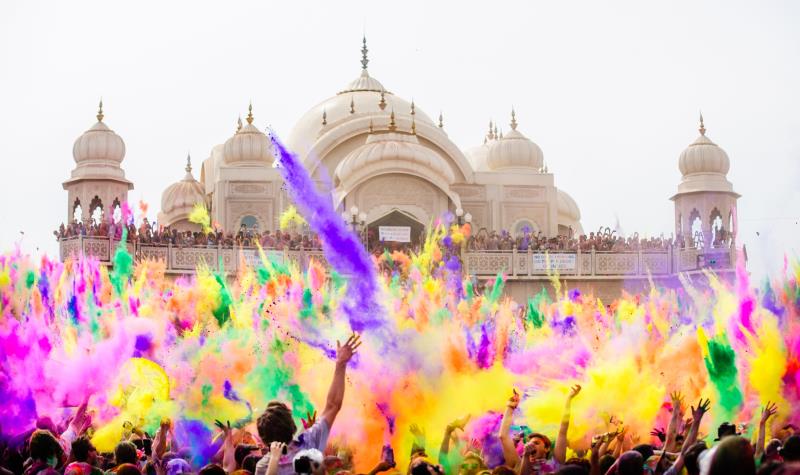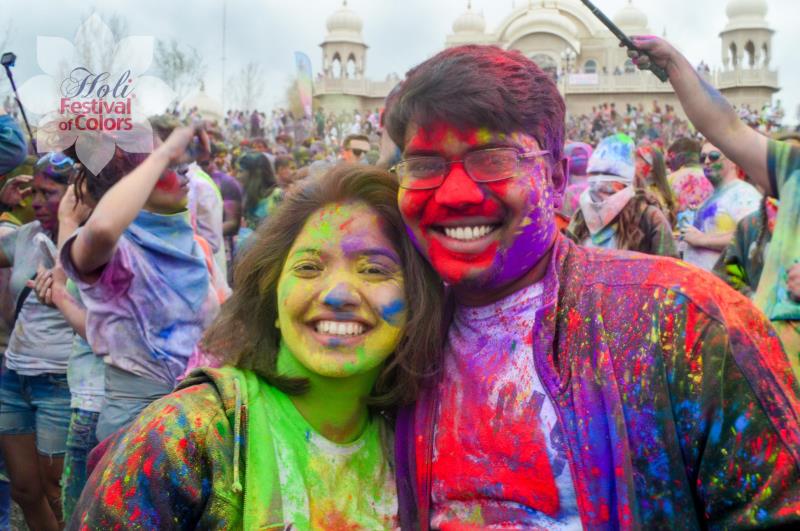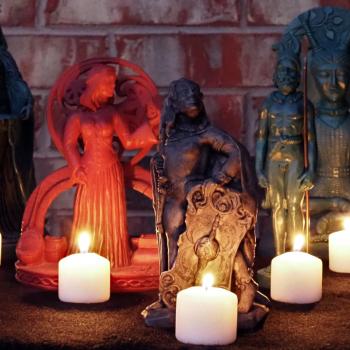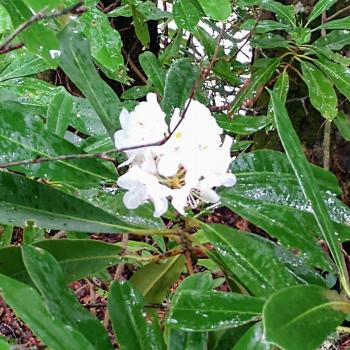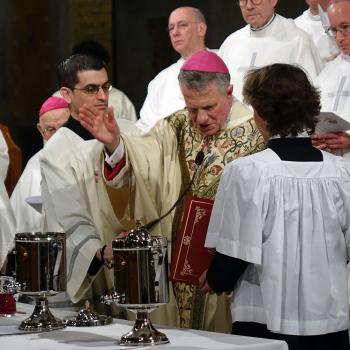
Religion Behind the Scenes spotlights the crucial but less visible tasks that keep religious communities running, and the people who make it all happen.
The central feature of every Holi festival is the colored powder that celebrants throw at one another. Known as the Festival of Colors, Holi has been celebrated in India since the fourth century. The holiday, which falls in the month of March, celebrates the beginning of spring and the end of the harsh winter. Many traditional stories are told about the origins of Holi, all emphasizing the triumph of good over evil. The holiday has a festive, joyful quality, underscored by the ancient tradition of covering everyone, and everything, with brightly colored powdered.
But how is the powder made? Where does one buy it? Why does some powder rise to the sky when thrown and some powder sinks to the earth?
In this ‘Behind the Scenes’ we talk to Caru Das, the largest supplier of Holi colored powder in the United States. He is the founder of two Krishna temples in Utah, and also organizes Holi festivals across the country, including his annual ‘Festival of Colors’ in his hometown of Spanish Fork, Utah, which gets over 35,000 festival attendees a year.
He breaks down for us everything there is to know about Holi colored powder, and what it takes to make a Holi festival.
***
How did the festivals start?
The first festival we only had a few people and we held it indoors—that was a huge mistake. We will never do that again. I was cleaning powder out of the floor six weeks later! Then we started holding them outdoors and, in 2007 or 2008, I started putting a little more money into it, and hiring musicians…then they really got going.
The festival is about celebrating spring after the chill and baroness of winter. I tell people, now is the time to just give up your resentments. Don't carry that. Don't carry that burden anymore. Just think of the colors as your resentments, your bitterness, the unfair situations. And when the colors go up, leave them behind. Don't let them define you. Walk away. Tomorrow is a new day. Hug your friends, hug your enemies. That's kind of what the festival was about in general. But then we wanted to tie it specifically to Krishna, and the love and devotion, which we did.
We tweaked the original concept in three important ways. One is we celebrated en masse. Instead of diffused color festivals all over, which had been traditional, we advertised for everyone together in one place, which hadn't been the case before. That was the first thing. The second thing was having countdowns instead of just throwing the color randomly. We had everybody save some powder for the top of the hour and then, in unison, you count down and then you throw colors up—and then hug each other. People get really excited here; the adrenaline is pumping; the musicians get really into it. That’s the second thing. And then the third thing was while we would have Indian music, we also have a lot of Western bands, with bass, guitar, keyboards, trumpets, saxophones, violin, and all of that to kind of bridge the gap between the East and the West, the young and the old, and cultures. That was the third thing.
People come, and they hang out with their friends. Not only do we cater, but we invite all kinds of food trucks on the property for that day. Of course, none of the food is meat, fish, or eggs. Everything is vegan to match the purity of the day. The powders we get are generally perfumed with jasmine and musk and sandalwood, so you not only get a visual bounty, but you also have a nice aroma wafting over the festival side as well. We just augmented what was already a traditional celebration and just tried to make the festival more meaningful than it had already been.
So the powder is the star of the day. How is it made? Can people make it themselves?
We don't have the machine or anything. We're just a temple, but we get the best quality exported from India. We've identified suppliers over there who are devotees, and they give us a really, really super price, which we pass on to the customer. They have a product which is free from heavy metals, free from any toxics or anything. Our powders are known for their brightness and vividness. Domestically, in the United States, a lot of powders are produced for the event organizers, which means they are easy to clean up. But that means it doesn’t really stick on your clothes. Our people like to get dirty. We don’t want powder that will just fall off, and then disappear in the air. This powder will stick to the clothes. Though it washes right off the skin in the shower.
Making the powder is quite a big investment, actually. It involves getting liquid food dye permeated through a big quantity of corn starch, and then it has to be mixed. You have these big mixing machines—I’ve heard that the machines can cost tens of thousands of dollars—and then it has to be dried. Once dried, it has to be mixed again because it tends to get cakey. People that try to make their own colors at home, in their oven, often end up with just a big dried cake of stuff.
Powder is gauged by different levels of density. How many particles per square foot? That sort of thing. That is another thing about our supplier. He achieves such a light density that the colors, when you throw them, they don't drop to the ground. They start to rise. They go up instead of down. The density depends on how expensive your equipment is. But it's not practical or possible to make it at home. People think they can do it. But our best customers, or our most loyal customers, are people that try to make it at home and never want to do that again.
What kind of orders do you get? Who are your customers?
I'm just packing an order right now for a Hindu Temple in Texas. It's a $1600 dollar order, and it’s about 475 pounds. It will be about 13 or 14 boxes, at 50 pounds a box. We get a lot of smaller orders too!
It's starting back up now, but it's been kind of a low time for everybody. The whole business rolled up overnight last March. March is normally our busiest month. And, in fact, this March a lot of people who ordered last year and didn’t use the colors don't have to reorder because they can use last year's colors. But we have up to 1000 people that appreciate our colors and appreciate our customer service in United States and Canada: most of them schools and nonprofits.
The color powders come in both individual packets and 1-kilogram bags. The packets are 100 grams each, with this bright label to indicate that we're the main dealers for those companies in America. For these, our customers are mainly Indian temples, Indian community groups, Indian Student Associations, or any schools and non-profits who want to recreate or celebrate Holi in a genuine way.
The main customers for the bulk orders are the color runs. There are all kinds of color runs that are celebrated all over the United States, and they don't need it in small bags. They have zones, and big buckets of color, and they just throw it out in front of the runners, and the runners run through a cloud of powder. So those are [the] best customers for the bulk. They came to us after the festivals started getting popular, and at first we resisted it because we wanted to preserve the spiritual significance and purity of it—and not have it be diluted or commercialized. But we realized that people are going to get colors one way or another, and they might as well get them from us, and at least help financially support our efforts.
How do you pack the colors? Presumably you have to be pretty careful.
We double wrap them. We put them in inside of about three garbage bags, and they themselves are in bags. We check them all for leaks before we pack them up, and then we triple bag them. So even if it leaks it will still be within the bag and still be usable powder. Not that it doesn’t happen, but it’s rare.
We get orders from throughout the United States, and Canada. We get some for the islands too. And we get a lot from military bases too. We have a lot, a lot of customers on military bases. Mostly, they're having color runs. So, we can ship all over.
What are the most popular colors?
All the colors are good, very bright and very vivid. I never broke it down, but hot pink, of course, is probably the most popular. There is yellow, orange, sky blue, royal blue, parrot green, grass green, teal.
They are all sumptuous. The problem is that when there are ten or more enticing colors, which four do I limit myself too?
Interview conducted, edited, and condensed by Shira Telushkin
--
Shira Telushkin is the managing editor of special projects at Patheos, where she combines her love of stories with her love of all things religion. A graduate of the Harvard Divinity School, she writes, edits, and produces media projects related to faith and beauty in all their forms.
7/13/2022 10:03:24 PM
